
Greenwich Armour
Encyclopedia
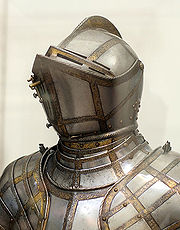
Greenwich
Greenwich is a district of south London, England, located in the London Borough of Greenwich.Greenwich is best known for its maritime history and for giving its name to the Greenwich Meridian and Greenwich Mean Time...
. The armoury's name came from the German master armourers hired by Henry VIII. During the 16th century the armoury was traditionally headed by Germans - the most notable armourer of the Greenwich workshop was Jacob Halder, who was master of the armoury from 1576 to 1607. This was the peak period of the armoury's production and it coincided with the elaborate, colourful fashion styles and decorative art characteristic of late Tudor England, incorporating these forms into the armour. As the use of full plate in actual combat had declined by the late 16th century, the Greenwich armours were primarily created not for battle but for the tournament. As such, this was a workshop which catered primarily to the nobility; the book of Greenwich armour designs for 24 different gentlemen, known as the "Jacob Album" after its creator, includes many of the most important figures of the Elizabethan court.
By the time of the mid-17th century, plate armour had adopted a stark and utilitarian form favoring thickness and protection (from the ever-more-powerful firearms which were redefining battle) over aesthetics and was generally only used by heavy cavalry
Heavy cavalry
Heavy cavalry is a class of cavalry whose primary role was to engage in direct combat with enemy forces . Although their equipment differed greatly depending on the region and historical period, they were generally mounted on large powerful horses, and were often equipped with some form of scale,...
; afterwards, it was to disappear more or less completely. Therefore, the Greenwich workshop represented the last flourishing of decorative armour-making in England, and comprises a unique genre of late-Renaissance art in its own right.
Henrician Period


Henry VIII of England
Henry VIII was King of England from 21 April 1509 until his death. He was Lord, and later King, of Ireland, as well as continuing the nominal claim by the English monarchs to the Kingdom of France...
, were typically of uniform colouration, either gilded or silvered all over and then etched with intricate motifs, often designed by Hans Holbein
Hans Holbein the Younger
Hans Holbein the Younger was a German artist and printmaker who worked in a Northern Renaissance style. He is best known as one of the greatest portraitists of the 16th century. He also produced religious art, satire and Reformation propaganda, and made a significant contribution to the history...
. The lines of these armours were typically not much different from Northern German designs of the same time period; the decorations, though, were often more extravagant. A good example of this early sort of Greenwich style is the harness which is thought to have belonged to Galiot de Genouillac, Constable of France
Constable of France
The Constable of France , as the First Officer of the Crown, was one of the original five Great Officers of the Crown of France and Commander in Chief of the army. He, theoretically, as Lieutenant-general of the King, outranked all the nobles and was second-in-command only to the King...
, but was initially created for King Henry. The armour, currently on display at the Metropolitan Museum of Art
Metropolitan Museum of Art
The Metropolitan Museum of Art is a renowned art museum in New York City. Its permanent collection contains more than two million works, divided into nineteen curatorial departments. The main building, located on the eastern edge of Central Park along Manhattan's Museum Mile, is one of the...
in New York
New York
New York is a state in the Northeastern region of the United States. It is the nation's third most populous state. New York is bordered by New Jersey and Pennsylvania to the south, and by Connecticut, Massachusetts and Vermont to the east...
, has a specially-designed corset
Corset
A corset is a garment worn to hold and shape the torso into a desired shape for aesthetic or medical purposes...
built into the cuirass
Cuirass
A cuirass is a piece of armour, formed of a single or multiple pieces of metal or other rigid material, which covers the front of the torso...
to support the weight of the burly king's large stomach. This harness also has very wide sabatons in the Maximilian
Maximilian armour
Maximilian armour is a modern term applied to the style of early 16th-century German plate armour apparently first made for the Emperor Maximilian I...
style. Very similar in design, but ungilded, is another tournament harness made for Henry VIII which now resides at the Tower of London
Tower of London
Her Majesty's Royal Palace and Fortress, more commonly known as the Tower of London, is a historic castle on the north bank of the River Thames in central London, England. It lies within the London Borough of Tower Hamlets, separated from the eastern edge of the City of London by the open space...
and which is famous for its large codpiece
Codpiece
A codpiece is a covering flap or pouch that attaches to the front of the crotch of men's trousers and usually accentuates the genital area. It was held closed by string ties, buttons, or other methods...
.
Golden Age
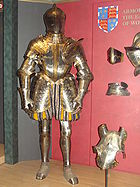
Doublet (clothing)
A doublet is a man's snug-fitting buttoned jacket that is fitted and shaped to the man's body which was worn in Western Europe from the Middle Ages through to the mid-17th century. The doublet was hip length or waist length and worn over the shirt or drawers. Until the end of the 15th century the...
which was immensely popular among gentlemen during the reign of Elizabeth. This type of cuirass curved outwards in front at a steep angle which culminated at the groin, where it tapered into a small horn-like protrusion. All-over gilding or silvering was replaced by strips of blued or gilded steel, typically running horizontally across the pauldrons at the edge of each lame, and vertically down the cuirass and tassets
Tassets
Tassets are a piece of plate armour designed to protect the upper legs. They take the form of separate plates hanging from the breastplate or faulds. They may be made from a single piece or segmented...
, which emulated the strips of colourful embroidered cloth that were popular in civilian fashion. Some armours were provided with an extra pair of tassets for use at the barriers which were very wide, not unlike the form of a pair of trunkhose. The extant armours of Robert Dudley, 1st Earl of Leicester
Robert Dudley, 1st Earl of Leicester
Robert Dudley, 1st Earl of Leicester, KG was an English nobleman and the favourite and close friend of Elizabeth I from her first year on the throne until his death...
and that of Henry Herbert, 2nd Earl of Pembroke
Henry Herbert, 2nd Earl of Pembroke
Henry Herbert, 2nd Earl of Pembroke KG was an English peer of the Elizabethan era.-Life:He was the son of William Herbert, 1st Earl of Pembroke and Anne Parr. His aunt was queen consort Catherine Parr, last wife of King Henry VIII. Herbert was responsible for the costly restoration of Cardiff Castle...
currently display these tassets. The armour of William Somerset, 3rd Earl of Worcester
William Somerset, 3rd Earl of Worcester
William Somerset, 3rd Earl of Worcester, KG was born before 1526 to Henry Somerset, 2nd Earl of Worcester and his second wife Elizabeth Browne....
is also similarly styled.

Maximilian armour
Maximilian armour is a modern term applied to the style of early 16th-century German plate armour apparently first made for the Emperor Maximilian I...
and Gothic
Gothic plate armour
Gothic plate armour is a type of plate armour of steel made in the regions of Germany and the Holy Roman Empire during the late Middle Ages . The armour provided full-body protection to the knight who wore it...
, tended to emphasize the shaping of the metal itself, such as fluting and roping, to create artistic designs in the armour, rather than using colour. The Greenwich style, however, saw an unprecedented use of many different colours to form vibrant, striking patterns. Colour contrast became extremely important, as it was in civilian fashion. The extent to which a suit of armour was decorated depended on the wealth of the buyer, and ranged from wildly elaborate and artistic pieces such as George Clifford's famous gilded garniture to relatively simple harnesses of "white armour" overlaid with intersecting patterns of darker-coloured strips. In either case, the use of contrasting colours became a hallmark of the Greenwich style.
There were three main ways in which the steel of the armour was coloured: bluing, browning, and russeting. Bluing the steel gave it a deep, brilliant blue-black finish.
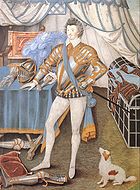
George Clifford, 3rd Earl of Cumberland
Sir George Clifford, 3rd Earl of Cumberland, KG was an English peer, as well as a naval commander and courtier in the court of Queen Elizabeth I.-Background:...
. Finally, russeting imparted a dark-red or purple hue to the steel, which was also typically used in conjunction with gilding. All of these base colours would be applied uniformly to the steel of the armour, and then strips of differently-coloured steel would be laid across to create patterns, or etched sections of the armour would be gilded. The Earl of Worcester's armour is one striking example of a scalloped design which was originally gilded over dark blued steel.
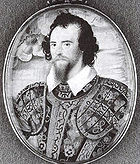
Armet
Armet is the name of a type of helmet developed in the 15th century, most likely in Italy, France, Spain and Hungary. It was distinguished by being the first helmet of its era to completely enclose the head while being compact and light enough to move with the wearer...
with a very high visor perforated on one or both sides by vertical slits, in the case of a field visor, or with small round holes in the case of a visor for the tilt (most Greenwich armours came with both types.) The rim of the upper bevor juts out forward gracefully, giving the helmet a characteristic "ship's prow" appearance. It also typically has a high raised comb from the rear of the skull extending up to the top of the visor, a feature influenced by the French style.
Finally, Greenwich armours were often made in the form of a garniture, which meant a large set of interchangeable armour pieces with the same design which could be arranged to form a suit for either mounted combat such as jousting, or combat on foot in the tournament. A garniture would typically include a full plate harness plus an extra visor specially meant for tilting; a burgonet
Burgonet
The burgonet helmet was a Renaissance-era and Early modern combat helmet. It was the successor of the sallet....
helmet which would be worn open-faced for a parade or ceremony, or with a removable "falling-buffe" visor for combat; a grandguard, which would reinforce the upper portion of the torso and neck for jousting; a passguard, which would reinforce the arm; and a manifer, a large gauntlet to protect the hand. It might also include a shaffron, which would cover the head of the knight's horse, and a set of decorated saddle steels.
Stuart Period
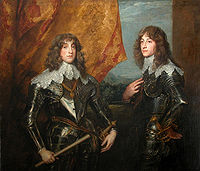
Henry Frederick, Prince of Wales
Henry Frederick Stuart, Prince of Wales was the elder son of King James I & VI and Anne of Denmark. His name derives from his grandfathers: Henry Stuart, Lord Darnley and Frederick II of Denmark. Prince Henry was widely seen as a bright and promising heir to his father's throne...
. This transition can be seen in the styling of the post-Jacobean Greenwich armour; gilded decoration and etching is now absent, and the steel is no longer russeted, polished "white" or boldly colored in any other way but is uniformly a simple blue-gray shade. Tassets are now frequently knee-length, in the cuirassier fashion. Also, in keeping with innovations in the field of armouring, the inner elbows are often fully protected by articulated lames. Nevertheless the Greenwich armours even into the period of the English Civil War
English Civil War
The English Civil War was a series of armed conflicts and political machinations between Parliamentarians and Royalists...
retained some of the distinctive touches of the last century; the breastplates were still shaped in the peascod fashion and the pauldrons had the same graceful and rounded curves (while those of Continental armours tended towards square shapes). The "ship's prow" form of the close helmet also remained, and can be seen in many portraits of important military figures from the English Civil War.
The Jacob Album

Staff of office
A staff of office is a staff, the carrying of which often denotes an official's position, a social rank or a degree of social prestige.Apart from the ecclesiastical and ceremonial usages mentioned below, there are less formal usages. A gold- or silver-topped cane can express social standing...
, and wearing the armour which was to be furnished for him. The wearers listed in the album include some of the most illustrious and powerful nobles of Elizabeth's court. Among them are Robert Dudley, 1st Earl of Leicester
Robert Dudley, 1st Earl of Leicester
Robert Dudley, 1st Earl of Leicester, KG was an English nobleman and the favourite and close friend of Elizabeth I from her first year on the throne until his death...
; William Herbert, 1st Earl of Pembroke, Sir Thomas Bromley, Lord Chancellor
Lord Chancellor
The Lord High Chancellor of Great Britain, or Lord Chancellor, is a senior and important functionary in the government of the United Kingdom. He is the second highest ranking of the Great Officers of State, ranking only after the Lord High Steward. The Lord Chancellor is appointed by the Sovereign...
of England; Sir Christopher Hatton, who succeeded Bromley as Lord Chancellor and was also rumored to be Queen Elizabeth's lover; Sir Henry Lee, Queen Elizabeth's first official jousting champion; and George Clifford, 3rd Earl of Cumberland
George Clifford, 3rd Earl of Cumberland
Sir George Clifford, 3rd Earl of Cumberland, KG was an English peer, as well as a naval commander and courtier in the court of Queen Elizabeth I.-Background:...
, the Queen's second official champion and also an important naval commander who briefly captured Fort San Felipe del Morro
Fort San Felipe del Morro
Also known as Fort San Felipe del Morro or Morro Castle, is a 16th-century citadel located in San Juan, Puerto Rico.- Rundown :Lies on the northwestern-most point of the islet of San Juan, Puerto Rico...
.
Other notable figures whose suits of armour are displayed in the album are Thomas Sackville, 1st Earl of Dorset
Thomas Sackville, 1st Earl of Dorset
Thomas Sackville, 1st Earl of Dorset was an English statesman, poet, dramatist and Freemason. He was the son of Richard Sackville, a cousin to Anne Boleyn. He was a Member of Parliament and Lord High Treasurer.-Biography:...
, who served as Lord High Treasurer
Lord High Treasurer
The post of Lord High Treasurer or Lord Treasurer was an English government position and has been a British government position since the Act of Union of 1707. A holder of the post would be the third highest ranked Great Officer of State, below the Lord High Chancellor and above the Lord President...
but is perhaps best known as the co-author of Gorboduc
Gorboduc
Gorboduc was a legendary king of the Britons as accounted by Geoffrey of Monmouth. He was married to Judon. At an old age, he became senile and his sons, Ferrex and Porrex, feuded over who would take over the kingdom...
, one of the first tragedies written in blank verse
Blank verse
Blank verse is poetry written in unrhymed iambic pentameter. It has been described as "probably the most common and influential form that English poetry has taken since the sixteenth century" and Paul Fussell has claimed that "about three-quarters of all English poetry is in blank verse."The first...
, and Sir James Scudamore
Sir James Scudamore
Sir James Scudamore was a gentleman usher at the court of Queen Elizabeth I. Born at Holme Lacy, Herefordshire, he was the eldest son of Sir John Scudamore, Custos Rotulorum of Herefordshire and his first wife Eleanor Croft, daughter of former Lord Deputy of Ireland James Croft...
, a gentleman usher
Gentleman Usher
Gentleman Usher is a title for some officers of the Royal Household of the United Kingdom. See List of Gentlemen Ushers for a list of office-holders.-Historical:...
and tilting champion who was the basis for the character "Sir Scudamour" in The Fairie Queene by Edmund Spenser
Edmund Spenser
Edmund Spenser was an English poet best known for The Faerie Queene, an epic poem and fantastical allegory celebrating the Tudor dynasty and Elizabeth I. He is recognised as one of the premier craftsmen of Modern English verse in its infancy, and one of the greatest poets in the English...
. One of the armours in the album is labeled as being for "John, Duke of Finland" - the future king John III of Sweden
John III of Sweden
-Family:John married his first wife, Catherine Jagellonica of Poland , house of Jagiello, in Vilnius on 4 October 1562. In Sweden, she is known as Katarina Jagellonica. She was the sister of king Sigismund II Augustus of Poland...
, who visited England in 1560 to promote a marriage between Queen Elizabeth and his brother Eric. Another design is for a man named Bale Desena, the identity of whom remains a mystery to this day. This man was likely not an Englishman, as his name (which is probably misspelled in the album) suggests Spanish or Italian origin. It is unknown how he commissioned a Greenwich armour, though these armours were sometimes given to foreigners as gifts. Christian of Brunswick, cousin and friend to Henry Frederick, Prince of Wales
Henry Frederick, Prince of Wales
Henry Frederick Stuart, Prince of Wales was the elder son of King James I & VI and Anne of Denmark. His name derives from his grandfathers: Henry Stuart, Lord Darnley and Frederick II of Denmark. Prince Henry was widely seen as a bright and promising heir to his father's throne...
, was given a beautiful gilded Greenwich armour which remained in the family of the Dukes of Brunswick before ultimately being purchased by Ronald Lauder
Ronald Lauder
Ronald Steven Lauder is a Jewish-American businessman, civic leader, philanthropist, and art collector. Forbes lists Lauder among the richest people of the world with an estimated net worth of $3.0 billion in 2007.-Life and career:...
.


Several of the armours depicted in this album survive to the present day. The armours of Robert Dudley, William Somerset, and William Herbert are all at the Royal Armouries
Royal Armouries
The Royal Armouries is the United Kingdom's National Museum of Arms and Armour. It is the United Kingdom's oldest museum, and one of the oldest museums in the world. It is also one of the largest collections of arms and armour in the world, comprising the UK's National Collection of Arms and...
at the Tower of London
Tower of London
Her Majesty's Royal Palace and Fortress, more commonly known as the Tower of London, is a historic castle on the north bank of the River Thames in central London, England. It lies within the London Borough of Tower Hamlets, separated from the eastern edge of the City of London by the open space...
, and Christopher Hatton's armour is at the Royal Armouries gallery in Leeds, along with the half-harness (the only one in the album) of a notable soldier, tactician and military writer of the Elizabethan era named John Smythe. The complete garniture of George Clifford
George Clifford, 3rd Earl of Cumberland
Sir George Clifford, 3rd Earl of Cumberland, KG was an English peer, as well as a naval commander and courtier in the court of Queen Elizabeth I.-Background:...
is on display at the Metropolitan Museum of Art
Metropolitan Museum of Art
The Metropolitan Museum of Art is a renowned art museum in New York City. Its permanent collection contains more than two million works, divided into nineteen curatorial departments. The main building, located on the eastern edge of Central Park along Manhattan's Museum Mile, is one of the...
in New York, along with the armours of Sir James Scudamore
Sir James Scudamore
Sir James Scudamore was a gentleman usher at the court of Queen Elizabeth I. Born at Holme Lacy, Herefordshire, he was the eldest son of Sir John Scudamore, Custos Rotulorum of Herefordshire and his first wife Eleanor Croft, daughter of former Lord Deputy of Ireland James Croft...
and Henry Herbert, 2nd Earl of Pembroke
Henry Herbert, 2nd Earl of Pembroke
Henry Herbert, 2nd Earl of Pembroke KG was an English peer of the Elizabethan era.-Life:He was the son of William Herbert, 1st Earl of Pembroke and Anne Parr. His aunt was queen consort Catherine Parr, last wife of King Henry VIII. Herbert was responsible for the costly restoration of Cardiff Castle...
. When compared with extant examples of the armour to which they correspond, the drawings in Jacob Topf's album are nearly-exact representations of the finished product. There is only one major difference, which is that the drawing for the armour of William Somerset, Earl of Worcester, shows a deep red russeted background with scalloped and gilded bands over it, whereas the portrait of the Earl clearly shows a black background. Other than that, the design matches the armour perfectly, including even the maille shoes. Several of the garnitures in the album feature an identical design - a series of gilt bands in a snaking S-shape pattern overlaid with interlacing diagonal lines in an X pattern, over a background of deeply-russeted steel of a purplish colour. The garnitures with this design are those belonging to Sir James Scudamore, William Compton, 1st Earl of Northampton
William Compton, 1st Earl of Northampton
William Compton, 1st Earl of Northampton, KG , known as 2nd Baron Compton from 1589 to 1618, was an English peer.Northampton was the son of Henry Compton, 1st Baron Compton, and Frances Hastings. His maternal grandparents were Francis Hastings, 2nd Earl of Huntingdon and Catherine Pole...
, and Thomas Sackville
Thomas Sackville
Thomas Sackville may refer to:*Thomas Sackville, 1st Earl of Dorset , English statesman, poet and playwright*Tom Sackville , British Conservative Member of Parliament...
, Lord Buckhurst.

